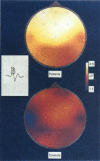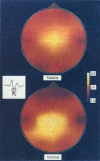Abstract
Neuroimaging studies of behavioral-induced anxiety in non-patients and of lactate-induced anxiety in panic disorder patients have indicated that normal and pathological anxiety may share a common pathway involving the temporal poles. As panic-related anxiety may reflect faulty temporopolar evaluative processing of input, the objective of this study was to examine sensory reactivity in panic disorder patients via scalp recordings of the late auditory evoked 'vertex' potential (LAEP) which appears to have a predominantly temporal lobe origin. Twelve patients diagnosed according to DSM-III criteria as panic disorder and ten normal controls served as subjects in this study. EEG was recorded from 16 scalp sites using a monopolar fronto-occipital derivation and LAEPs were separately averaged in response to four acoustic intensities. Analysis focused on group and electrode-site differences in the negative (N1) and positive (P2) component amplitudes of the LAEPs. Panic disorder patients were found to exhibit significantly larger N1 amplitudes across all stimulus intensities and across all recording sites. No significant group differences were observed with P2. Although the results provide indirect support for a temporal focus, other modulating influences must be considered in data interpretation.
Full text
PDF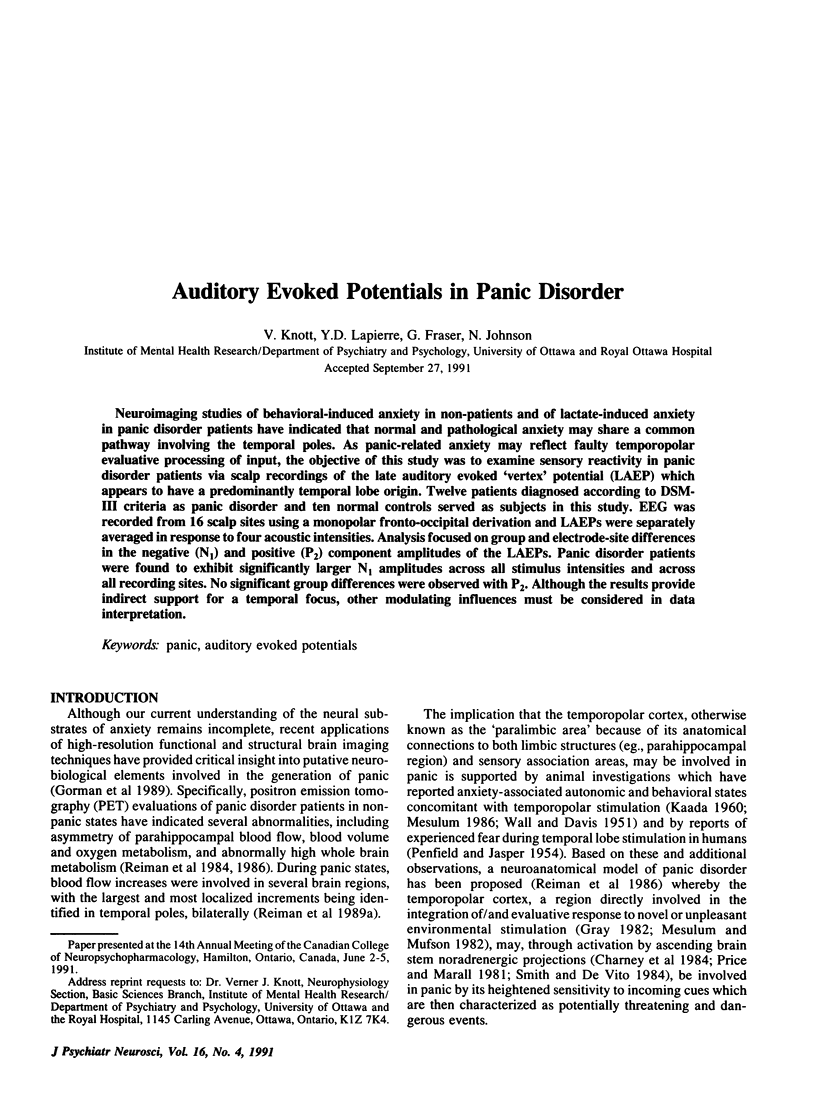
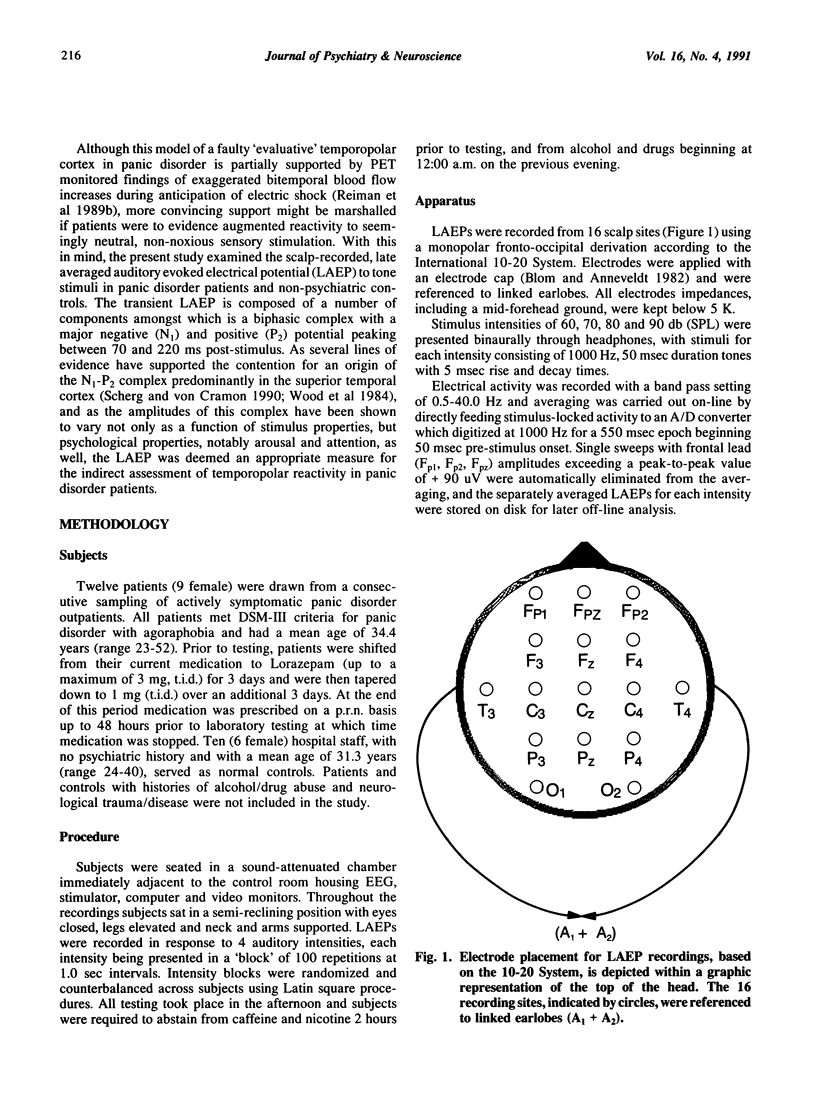

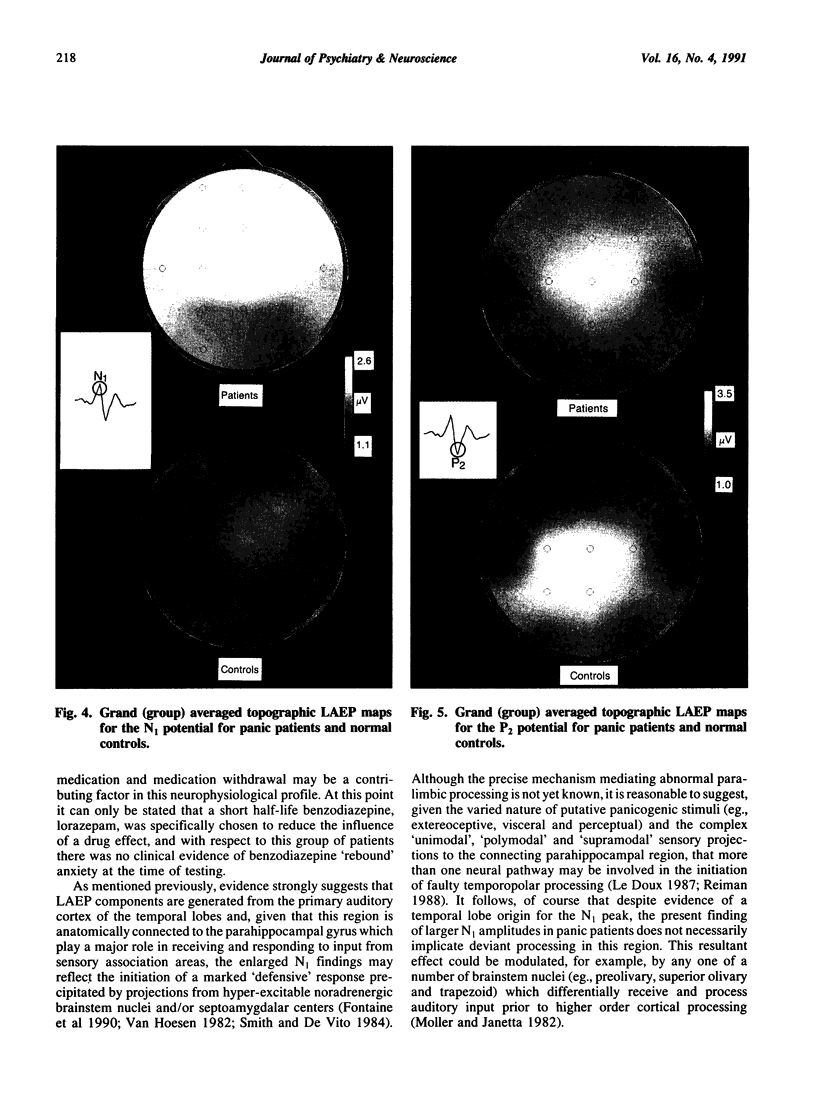
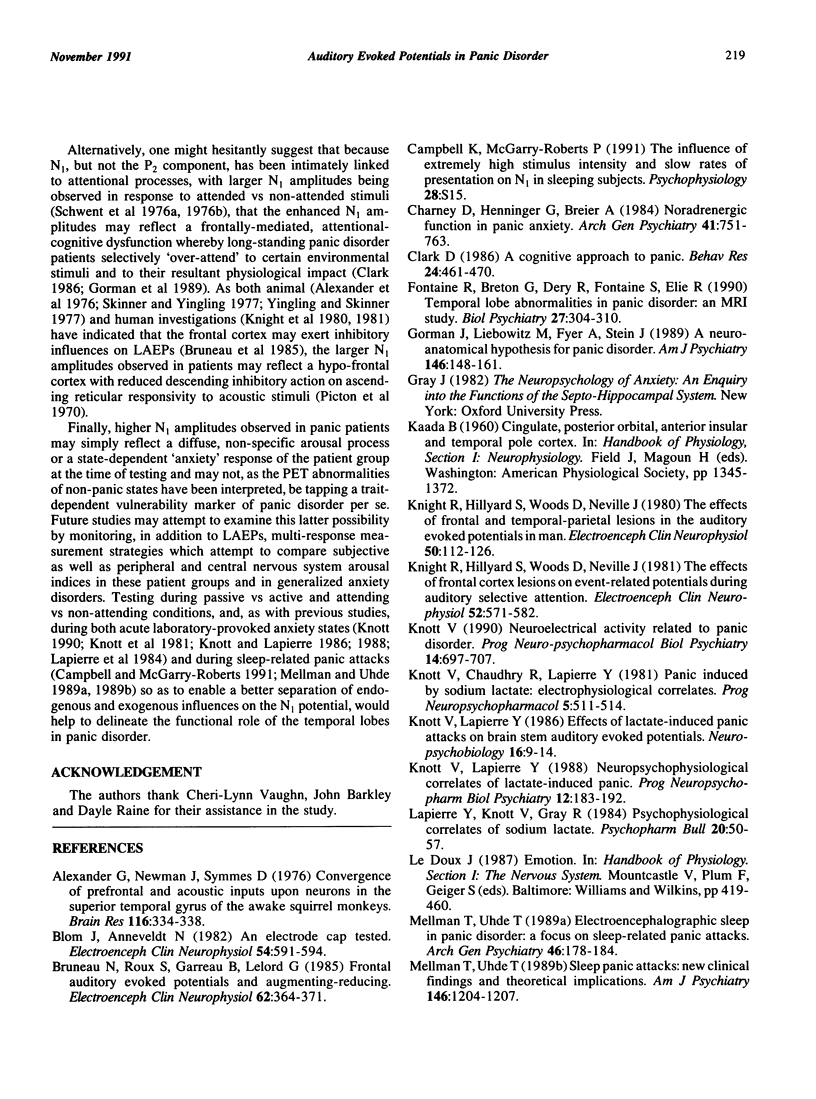

Images in this article
Selected References
These references are in PubMed. This may not be the complete list of references from this article.
- Alexander G. E., Newman J. D., Symmes D. Convergence of prefrontal and acoustic inputs upon neurons in the superior temporal gyrus of the awake squirrel monkey. Brain Res. 1976 Nov 5;116(2):334–338. doi: 10.1016/0006-8993(76)90913-6. [DOI] [PubMed] [Google Scholar]
- Blom J. L., Anneveldt M. An electrode cap tested. Electroencephalogr Clin Neurophysiol. 1982 Nov;54(5):591–594. doi: 10.1016/0013-4694(82)90046-3. [DOI] [PubMed] [Google Scholar]
- Bruneau N., Roux S., Garreau B., Lelord G. Frontal auditory evoked potentials and augmenting-reducing. Electroencephalogr Clin Neurophysiol. 1985 Sep;62(5):364–371. doi: 10.1016/0168-5597(85)90045-0. [DOI] [PubMed] [Google Scholar]
- Charney D. S., Heninger G. R., Breier A. Noradrenergic function in panic anxiety. Effects of yohimbine in healthy subjects and patients with agoraphobia and panic disorder. Arch Gen Psychiatry. 1984 Aug;41(8):751–763. doi: 10.1001/archpsyc.1984.01790190025003. [DOI] [PubMed] [Google Scholar]
- Clark D. M. A cognitive approach to panic. Behav Res Ther. 1986;24(4):461–470. doi: 10.1016/0005-7967(86)90011-2. [DOI] [PubMed] [Google Scholar]
- Fontaine R., Breton G., Déry R., Fontaine S., Elie R. Temporal lobe abnormalities in panic disorder: an MRI study. Biol Psychiatry. 1990 Feb 1;27(3):304–310. doi: 10.1016/0006-3223(90)90004-l. [DOI] [PubMed] [Google Scholar]
- Gorman J. M., Liebowitz M. R., Fyer A. J., Stein J. A neuroanatomical hypothesis for panic disorder. Am J Psychiatry. 1989 Feb;146(2):148–161. doi: 10.1176/ajp.146.2.148. [DOI] [PubMed] [Google Scholar]
- Knight R. T., Hillyard S. A., Woods D. L., Neville H. J. The effects of frontal and temporal-parietal lesions on the auditory evoked potential in man. Electroencephalogr Clin Neurophysiol. 1980 Oct;50(1-2):112–124. doi: 10.1016/0013-4694(80)90328-4. [DOI] [PubMed] [Google Scholar]
- Knight R. T., Hillyard S. A., Woods D. L., Neville H. J. The effects of frontal cortex lesions on event-related potentials during auditory selective attention. Electroencephalogr Clin Neurophysiol. 1981 Dec;52(6):571–582. doi: 10.1016/0013-4694(81)91431-0. [DOI] [PubMed] [Google Scholar]
- Knott V. J., Lapierre Y. D. Effects of lactate-induced panic attacks on brain stem auditory evoked potentials. Neuropsychobiology. 1986;16(1):9–14. doi: 10.1159/000118290. [DOI] [PubMed] [Google Scholar]
- Knott V. J., Lapierre Y. D. Neuropsychophysiological correlates of lactate-induced panic. Prog Neuropsychopharmacol Biol Psychiatry. 1988;12(2-3):183–192. doi: 10.1016/0278-5846(88)90036-x. [DOI] [PubMed] [Google Scholar]
- Knott V. J. Neuroelectrical activity related to panic disorder. Prog Neuropsychopharmacol Biol Psychiatry. 1990;14(5):697–707. doi: 10.1016/0278-5846(90)90040-n. [DOI] [PubMed] [Google Scholar]
- Knott V., Chaudhry R., Lapierre Y. D. Panic induced by sodium lactate: electrophysiological correlates. Prog Neuropsychopharmacol. 1981;5(5-6):511–514. doi: 10.1016/0364-7722(81)90036-9. [DOI] [PubMed] [Google Scholar]
- Lapierre Y. D., Knott V. J., Gray R. Psychophysiological correlates of sodium lactate. Psychopharmacol Bull. 1984 Winter;20(1):50–57. [PubMed] [Google Scholar]
- Mellman T. A., Uhde T. W. Electroencephalographic sleep in panic disorder. A focus on sleep-related panic attacks. Arch Gen Psychiatry. 1989 Feb;46(2):178–184. doi: 10.1001/archpsyc.1989.01810020080013. [DOI] [PubMed] [Google Scholar]
- Mellman T. A., Uhde T. W. Sleep panic attacks: new clinical findings and theoretical implications. Am J Psychiatry. 1989 Sep;146(9):1204–1207. doi: 10.1176/ajp.146.9.1204. [DOI] [PubMed] [Google Scholar]
- Mesulam M. M., Mufson E. J. Insula of the old world monkey. I. Architectonics in the insulo-orbito-temporal component of the paralimbic brain. J Comp Neurol. 1982 Nov 20;212(1):1–22. doi: 10.1002/cne.902120102. [DOI] [PubMed] [Google Scholar]
- Møller A. R., Jannetta P. J. Auditory evoked potentials recorded intracranially from the brain stem in man. Exp Neurol. 1982 Oct;78(1):144–157. doi: 10.1016/0014-4886(82)90196-0. [DOI] [PubMed] [Google Scholar]
- Picton T. W., Hillyard S. A., Krausz H. I., Galambos R. Human auditory evoked potentials. I. Evaluation of components. Electroencephalogr Clin Neurophysiol. 1974 Feb;36(2):179–190. doi: 10.1016/0013-4694(74)90155-2. [DOI] [PubMed] [Google Scholar]
- Price J. L., Amaral D. G. An autoradiographic study of the projections of the central nucleus of the monkey amygdala. J Neurosci. 1981 Nov;1(11):1242–1259. doi: 10.1523/JNEUROSCI.01-11-01242.1981. [DOI] [PMC free article] [PubMed] [Google Scholar]
- Reiman E. M., Fusselman M. J., Fox P. T., Raichle M. E. Neuroanatomical correlates of anticipatory anxiety. Science. 1989 Feb 24;243(4894 Pt 1):1071–1074. doi: 10.1126/science.2784226. [DOI] [PubMed] [Google Scholar]
- Reiman E. M., Raichle M. E., Butler F. K., Herscovitch P., Robins E. A focal brain abnormality in panic disorder, a severe form of anxiety. Nature. 1984 Aug 23;310(5979):683–685. doi: 10.1038/310683a0. [DOI] [PubMed] [Google Scholar]
- Reiman E. M., Raichle M. E., Robins E., Butler F. K., Herscovitch P., Fox P., Perlmutter J. The application of positron emission tomography to the study of panic disorder. Am J Psychiatry. 1986 Apr;143(4):469–477. doi: 10.1176/ajp.143.4.469. [DOI] [PubMed] [Google Scholar]
- Reiman E. M., Raichle M. E., Robins E., Mintun M. A., Fusselman M. J., Fox P. T., Price J. L., Hackman K. A. Neuroanatomical correlates of a lactate-induced anxiety attack. Arch Gen Psychiatry. 1989 Jun;46(6):493–500. doi: 10.1001/archpsyc.1989.01810060013003. [DOI] [PubMed] [Google Scholar]
- Reiman E. M. The quest to establish the neural substrates of anxiety. Psychiatr Clin North Am. 1988 Jun;11(2):295–307. [PubMed] [Google Scholar]
- Schwent V. L., Hillyard S. A., Galambos R. Selective attention and the auditory vertex potential. Effects of signal intensity and masking noise. Electroencephalogr Clin Neurophysiol. 1976 Jun;40(6):615–622. doi: 10.1016/0013-4694(76)90136-x. [DOI] [PubMed] [Google Scholar]
- Schwent V. L., Hillyard S. A., Galambos R. Selective attention and the auditory vertex potential. I. Effects of stimulus delivery rate. Electroencephalogr Clin Neurophysiol. 1976 Jun;40(6):604–614. doi: 10.1016/0013-4694(76)90135-8. [DOI] [PubMed] [Google Scholar]
- Smith O. A., DeVito J. L. Central neural integration for the control of autonomic responses associated with emotion. Annu Rev Neurosci. 1984;7:43–65. doi: 10.1146/annurev.ne.07.030184.000355. [DOI] [PubMed] [Google Scholar]
- WALL P. D., DAVIS G. D. Three cerebral cortical systems affecting autonomic function. J Neurophysiol. 1951 Nov;14(6):507–517. doi: 10.1152/jn.1951.14.6.507. [DOI] [PubMed] [Google Scholar]
- Wood C. C., McCarthy G., Squires N. K., Vaughan H. G., Woods D. L., McCallum W. C. Anatomical and physiological substrates of event-related potentials. Two case studies. Ann N Y Acad Sci. 1984;425:681–721. doi: 10.1111/j.1749-6632.1984.tb23595.x. [DOI] [PubMed] [Google Scholar]




